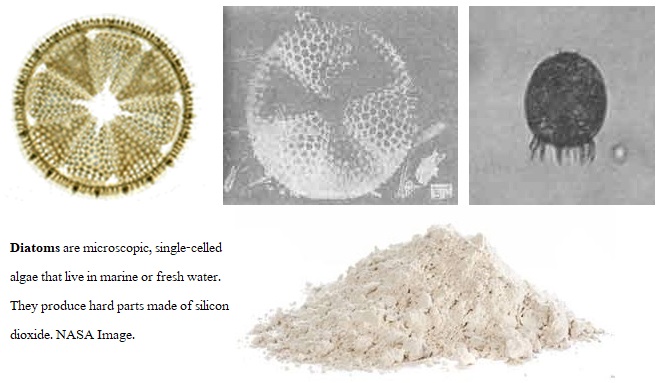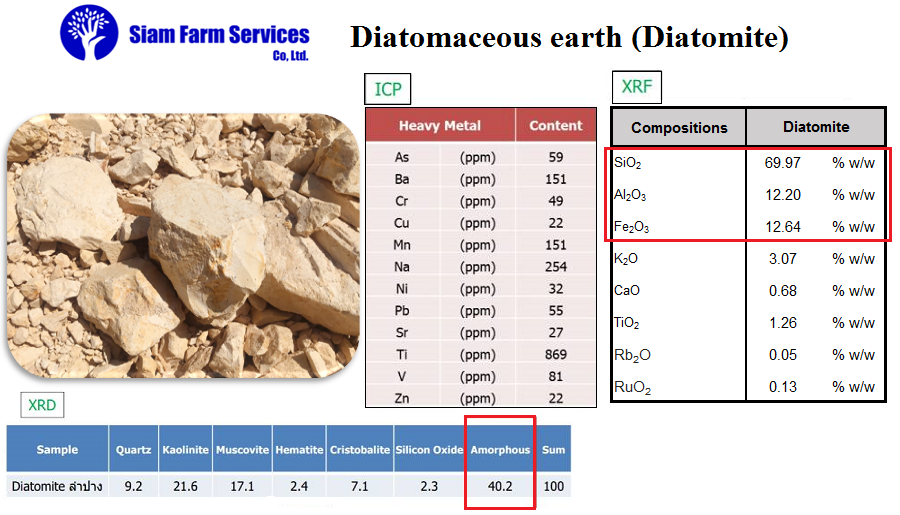Diatomaceous earth (Diatomite)

ดินเบา หรือ ไดอะตอมไมต์ (Diatomite) เป็นดินที่เกิดจากซากไดอะตอมในแหล่งไดอะตอม เป็นดินซุย เบา เนื้อพรุน มีลักษณะคล้ายชอล์ก มีปฏิกิริยาทางเคมีเชื่องช้า เป็นตัวนำความร้อนที่เลว จึงมีประโยชน์เป็นส่วนผสมในการทำกระดาษสาเพื่อให้เนื้อกระดาษแน่นเนียน เป็นฉนวน และเป็นสารที่ใช้ในการกรองได้ดี เช่น กรองน้ำตาลและสารกรองอื่นๆ ดินชนิดนี้ใช้ขัดภาชนะโลหะได้ดี เพราะมี ซิลิกาขนาดละเอียดยิบอยู่ในเนื้อ นอกจากนี้ยังใช้เป็นตัวดูดซับหรือฉนวนในระเบิดไดนาไมต์ด้วย

ดินเบา เป็นหินตะกอนที่มีสารจำพวกซิลิกาเป็นองค์ประกอบ มีลักษณะอ่อนนุ่ม เกิดขึ้นตามธรรมชาติ เป็นผงขนาดเล็ก ละเอียดสีขาว มีขนาดของผงอยู่ในช่วง น้อยกว่า 1 ไมครอน ไปจนถึงมากกว่า 1 มิลลิเมตร แต่ที่พบโดยปกติจะอยู่ในช่วง 10 ถึง 200 ไมครอน องค์ประกอบทางเคมีคือ สารจำพวกซิลิกา 80-90 % สารจำพวกอลูมินา (พบในแร่ดินเป็นส่วนใหญ่) 2-4% และ สารจำพวกเหล็กออกไซด์ 0.5-2%

ไดอะตอมไมต์ประกอบด้วยซากดึกดำบรรพ์ของไดอะตอม ซึ่งเป็นจำพวกหนึ่งของสาหร่ายเปลือกแข็ง สามารถใช้เป็นเครื่องกรอง สารขัดถู ยาฆ่าแมลง ใช้ประโยชน์ในการแพทย์โดยเป็นตัวกระตุ้นให้เลือดแข็งตัวเร็ว เป็นส่วนปะกอบของระเบิดไดนาไมต์ นอกจากนี้ใช้เป็นฉนวนความร้อน
ในภาษาอังกฤษ มีคำศัพท์หลายคำใช้เรียกดินเบานี้ ได้แก่ diatomaceous earth, diatomite, infusorial earthm siliceous earth, Kieselguhr เป็นต้น
ลักษณะทางธรณีวิทยาและการเกิด
ไดอะตอมไมต์มีการสะสมตัวโดยสารจำพวกซิลิกาไร้สัณฐาน หรือ โอปอล (SiO2•nH2O) เป็นไดอะตอม (สาหร่ายเซลล์เดียว) ที่ตายแล้ว สะสมตัวอยู่ในทะเลสาบน้ำจืดและทะเล ซากฟอสซิลประกอบด้วยเปลือก และผนังเซลล์ที่เป็นสารจำพวกซิลิกา ลักษณะสมมาตร

ไดอะตอมไมต์เริ่มมีการสะสมตัวในช่วง ยุคเทอร์เซียร์รีถึงยุดควอร์เทอนารี ส่วนการสะสมตัวในช่วงอายุแก่กว่า ได้แก่ยุคครีเตเซียสทำให้ได้ลักษณะซากฟอสซิลไม่สมบูรณ์ พบไดอะตอมไมต์สะสมตัวร่วมกับบริเวณภูเขากไฟ ทำให้ได้ลักษณะ ไดอะตอมไมต์ที่มีเถ้าฝุ่นภูเขาไฟผสมอยู่
การนำไปใช้ประโยชน์
1. อุตสาหกรรม - ในปีค.ศ. 1866 อัลแฟรด โนเบลได้ค้นพบว่าสารไนโตรกลีเซอรีนสามารถทำให้เสถียรมากกว่าถ้าถูกดูดกลืนในไดอะตอมไมต์ และไนโตรกลีเซอรีนที่เก็บกับไดอะตอมไมต์มีความปลอดภัยมากกว่า ไนโตรกลีเซอรีนแบบปกติ ต่อมาเขาได้จดสิทธิบัตรที่ประดิษฐ์ไดนาไมต์ขึ้น ในปี 1867
2. สารกรอง - ส่วนมากใช้ไดอะตอมไมต์ประมาณ 68% ซึ่งเป็นสารกรองขนาดกลางสำหรับกรองน้ำในสระว่ายน้ำ เหตุที่ใช้เป็นสารกรองเพราะมันมีรูพรุนจำนวนมาก สารกรองขนาดเล็ก ในทางเคมีชื่อ Celatom หรือ Celite ใช้ในการกรองน้ำดื่ม และกรองในอุตสาหกรรมของเหลวอื่นๆ เช่น เบียร์ ไวน์ นอกจากนี้ใช้ทำในอุตสาหกรรมอื่นๆ เช่น กระดาษ สี เซรามิก สบู่ ผงซักฟอก
3. สารขัดถู - ไดอะตอมไมต์ใช้เป็นสารขัดถูอย่างอ่อนโยน โดยใช้ในอุตสาหกรรมผลิตยาสีฟัน สารขัดเครื่องโลหะ และ สครับขัดหน้า
4. สารฆ่าแมลง - ไดอะตอมไมต์สามารถใช้เป็นยาฆ่าแมลง โดยไดอะตอมไมต์เป็นผงขนาดล็กสามารถดูดซึมของเหลวจากชั้นนอกสุดที่เป็นสารเคลือบของแมลง ทำให้แมลงตายได้ ราวปี 1930-1940 ได้มีการเริ่มนำดินเบามาใช้กำจัดแมลงในโรงเก็บโดยจำหน่ายเป็นการค้าชื่อ ”Naaki” ในประเทศเยอรมัน และ “Neoxyl” ในประเทศอังกฤษโดยนำมาคลุกกับเมล็ด และในอีกหลายประเทศก็ได้นำมาใช้กำจัดแมลงทั้งในโรงเก็บและแมลงศัตรูในชุมชน เช่นใช้ในควบคุมแมลงที่ติดไปกับยานพาหนะ โรงเรือน และโรงงานอุตสาหกรรมเกี่ยวกับอาหาร อาหารสัตว์ นอกจากนี้ดินเบายังนำไปใช้ในการกำจัดแมลงศัตรูทางการเกษตรอีกด้วย
5. สารฉนวนกันความร้อน - ไดอะตอมไมต์มีลักษณะเป็นฉนวนกันความร้อน ใช้ในการผลิตวัตถุกันไฟไหม้ได้ ตัวอย่างเช่น หลังคากันฉนวน, อิฐเก็บรักษาความร้อน, แคลเซียมซิลิเกตวัสดุที่เก็บรักษาความร้อน, ดินเหนียวที่มีรูพรุน, ฉนวนกันเสียง, กระดานฉนวนกันเสียงผนัง ฯลฯ การเก็บรักษาการเก็บรักษาความร้อน, ฉนวนกันความร้อน, วัสดุก่อสร้างฉนวนกันเสียง, กระดานฉนวนกันเสียงผนัง, กระเบื้องปูพื้น, ผลิตภัณฑ์เซรามิก ฯลฯ
6. สาร DNA บริสุทธิ์ - ไดอะตอมไมต์สามารถสกัดเอา DNA ออกมา ในสารเคมีเข้มข้นสูง เมื่อเทียบกับสารจำพวกซิลิเกตอื่นๆ ไดอะตอมสามารถสกัดออกมาได้ทั้ง DNA RNA และสารจำพวกโปรตีน
7. การเกษตร - ในธรรมชาติไดอะตอมไมต์น้ำจืดใช้ในการการเกษตรโดยใช้ผสมกับสารเพื่อไม่ให้สารจับเป็นก้อน เช่น ผสมในสารฆ่าแมลง สามารถใช้กำจัดหนอน โดยสารฆ่าแมงดังกล่าวเป็นสาอินทรีย์ทำให้มีความปลอดภัยต่อผู้บริโภค
8. ปุ๋ยอินทรีย์ - เนื่องจากดินเบามีประสิทธิภาพการดูดซับที่ดี, มีความหนาแน่นเล็กน้อย, มีขนาดเล็ก, ค่า PH เป็นกลาง, ปลอดสารพิษ, ผสมง่ายและมีความสม่ำเสมอดี ดินเบาจะกลายเป็นปุ๋ยที่มีประสิทธิภาพในการปลูกพืช, ผัก, ผลไม้, ดอกไม้ และ การปรับปรุงดิน ฯลฯ
9. สารกันความชื้น: ดินเบามีลักษณะเป็นรูพรุน สามารถดูดซับความชืนได้ดี และมีน้ำหนักเบา ใช้งานง่าย ปลอดสารพิษไม่เป็นอัตราย มีความ PH เป็นกลาง
10. อาหารสัตว์: เนืองจาก ดินเบามี ค่า PH เป็นกลาง, ไม่เป็นพิษ, ดินเบา มีโครงสร้างรูพรุน, น้ำหนักเบานุ่ม, โปร่งแสง, ประสิทธิภาพการดูดซับที่ดี, สร้างสีอ่อนนุ่ม, รักษาคุณภาพอาหารไม่ให้หายไปและมีอนุภาคผสมของพันธะในอาหารซึ่งไม่ใช่เรื่องง่ายที่จะแยกออกจากกัน, การเลี้ยงปศุสัตว์ และกระตุ้นย่อยในสัตว์ปีก, ลำไส้สัตว์ปีกและแบคทีเรียในกระเพาะอาหาร, ทำให้ปศุสัตว์มีสุขภาพแข็งแรง, ผลิตภัณฑ์อาหารสัตว์น้ำ ช่วยดูดซับเนื้ออาหารไม่ให้ละลายไปกับน้ำได้ดี, ช่วยเพิ่มอัตราการอยู่รอดของสัตว์น้ำ จึงนิยมน้ำมาเป็นส่วนประกอบของอาหารหมู,วัว, ไก่, เป็ด, ห่าน, ปลา, นก, ผลิตภัณฑ์สัตว์น้ำ ฯลฯ
Diatomite (diatomaceous earth) or Diatom (diatomite mineral scientific name) is caused by the deposition of soil remains of diatoms, a very small one-celled plants from 2-2000 micron like silica cap splice. Diatoms found in Water resources worldwide, both freshwater and saltwater, brackish water, there were about 12,000-16,000 types, some of them can swim but some need water borne. When diatoms died, it become the shell of silica that deposition to be a source of diatoms....
Explosives
In 1866, Alfred Nobel discovered that nitroglycerin could be made much more stable if absorbed in diatomite. This allows much safer transport and handling than nitroglycerin in its raw form. He patented this mixture as dynamite in 1867; the mixture is also called guhr dynamite.
Diatomite Uses
1. Filtration - The small particle size of diatomaceous earth and the open structure of the frustules enable it to work effectively as a particle filter. The pores within and between the frustule are small enough to trap bacteria, clay particles, and other suspended solids. It is used at drinking water treatment plants, swimming pools, breweries, wineries, chemical plants, and where juices and syrups are made. These fluids are forced through a layer of wet diatomaceous earth, and suspended particles are trapped because they cannot fit through the pores.
2. Cement Additive - Diatomite is often used as an additive in the manufacture of portland cement. High-quality diatomite contains over 80% silica, and it is added to the cement-making process to boost the silica content of the product. Diatomite straight from the mine is crushed and blended with the limestone, shale, or other materials being used to make the cement.
3. Absorbent - If dry diatomaceous earth is placed on a liquid spill, it can absorb and hold an amount of liquid equivalent to its own weight. This absorption facilitates containment, cleanup, and removal. Capillary action of liquids into diatomaceous earth is enhanced by its small particle size, high surface area, and its high porosity.
These same properties make diatomaceous earth able to absorb skin oils when used in cosmetics and facial masks. Diatomaceous earth is an absorbent ingredient of some kitty litters. It is also used as a soil treatment to absorb and hold water.
4. Filler - Diatomaceous earth is used as a lightweight, inert filler in some manufactured products. It is added to paint as a whitening agent and extender. It is added to plastics as a lightweight filler. It is used as a filler and anti-stick agent in asphalt shingles. It is used as a filler and to improve adhesion resistance in many rubber products. One form of diatomaceous earth is used as a filter medium, especially for swimming pools. It has a high porosity because it is composed of microscopically small, hollow particles. Diatomaceous earth is used in chemistry as a filtration aid, to filter very fine particles that would otherwise pass through or clog filter paper. It is also used to filter water, particularly in the drinking water treatment process and in fish tanks, and other liquids, such as beer and wine. It can also filter syrups, sugar, and honey without removing or altering their color, taste, or nutritional properties.


5. Mild Abrasive - Diatomaceous earth is used as a mild abrasive in some toothpastes, facial scrubs, and metal polishes. Its silica particles are small, friable, have a high surface area, and are angular in shape. These are properties that help it perform well as a mild abrasive.
6. Gardening - Diatomaceous earth is used as a growing medium in hydroponic gardens. It is inert, holds water, and has a porosity that allows the soil to breathe. To help grain and other seeds from sticking together and remain dry, they are dusted with diatomaceous earth. Freshwater diatomite can be used as a growing medium in hydroponic gardens. It is also used as a growing medium in potted plants, particularly as bonsai soil. Bonsai enthusiasts use it as a soil additive, or pot a bonsai tree in 100% diatomaceous earth. In vegetable gardening it is sometimes used as a soil conditioner, because like perlite, vermiculite, and expanded clay, it retains water and nutrients, while draining fast and freely, allowing high oxygen circulation within the growing medium.
7. Insect and Slug Control - Diatomaceous earth is an abrasive and an absorbent. These properties make it effective in controlling slugs and certain insects. To control ants, fleas, roaches, lice, mites, and ticks indoors, vacuum the infested area, then dust it with a small amount of diatomaceous earth. Repeat every few weeks until resolved.
Slugs can be deterred outdoors by dusting problem areas with diatomaceous earth. If slugs are disturbing plants, dust the soil around the base of the plant. Diatomaceous earth works only when dry. The best time to apply it is when slugs are present and rain is not expected for at least 24 hours.
8. Flea and Tick Control - Dogs and cats can be treated with food-grade diatomaceous earth to control fleas and ticks. Before treating the pet, clean their bedding materials, and vacuum rugs where the pet is allowed to roam. Then lightly dust these areas with diatomaceous earth. Repeat every few days.
To treat the pet, brush, comb, and inspect the animal to remove fleas and ticks. Then dust the pet lightly with diatomaceous earth. Bathe the pet after two or three days with a moisturizing shampoo. After the bath, brush or comb the pet to remove any fleas or ticks that remain. Repeat dusting and combing every few days. Bathe the pet about once a month with moisturizing shampoo.
9.Supplement - Diatomite is increasingly being used a supplement by humans. Diatomite has several uses for humans, including use for internal cleansing, heavy metal detoxification, joint and bone support, weight loss, digestive support, and much more. Of course much of this is now known as food grade diatomaceous earth.
10. Thermal - Its thermal properties enable it to be used as the barrier material in some fire resistant safes.[citation needed] It is also used in evacuated powder insulation for use with cryogenics.Diatomaceous earth powder is inserted into the vacuum space to aid in the effectiveness of vacuum insulation. It was used in the Classical AGA Cookers as a thermal heat barrier.
11. Marker in livestock nutrition experiments - Natural dried, not calcined diatomaceous earth is regularly used in livestock nutrition research as a source of acid insoluble ash (AIA), which is used as an indigestible marker. By measuring the content of AIA relative to nutrients in test diets and feces or digesta sampled from the terminal ileum (last third of the small intestine) the percentage of that nutrient digested.Natural freshwater diatomaceous earth is preferred by many researchers over chromic oxide, which has been widely used for the same purpose, the latter being a known carcinogen and, therefore, a potential hazard to research personnel.
Freshwater vs. Saltwater Diatomite
Diatomite forms in marine water and freshwater environments. These origins are an important consideration when a diatomite source is being considered for use. Any use that will be associated with human, animal, or plant contact should come from freshwater deposits. Diatomite from saltwater sources can contain salts that can produce objectionable or toxic effects.
Referee :
https://en.wikipedia.org/wiki/Diatomaceous_earth
